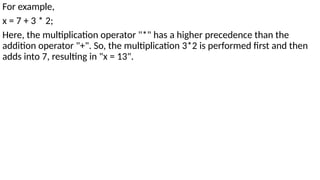Programming in C - Introduction to C Language
- 1. UNIT 1 OVERVIEW OF C
- 2. HISTORY Background and Origins ALGOL (1958): One of the first programming languages that influenced many languages including C. Introduced by Friedrich, John Backus, Peter Naur, Heinz RutisHauser. BCPL (Basic Combined Programming Language, 1966): Developed by Martin Richards, it influenced the development of B language. B Language (1969): Created by Ken Thompson, it was the direct predecessor of C. Development of C 1972: Dennis Ritchie developed C at Bell Labs for the Unix operating system. Evolution of C 1978: The publication of "The C Programming Language" by Brian Kernighan and Dennis Ritchie, also known as K&R C. 1989/1990: ANSI C and ISO C (C89/C90) ANSI (American National Standards Institute): Standardized the language, ensuring portability and consistency.
- 3. 1999: C99 Improvements: Added new features like inline functions, variable-length arrays, and several new data types. 2011: C11 Enhancements: Multithreading support, improved Unicode support, and new standard libraries. 2018: C18 Latest Standard: Mainly bug fixes and minor improvements over C11.
- 4. Characteristics of C • Procedural Language: Emphasizes procedures or routines. • General-purpose: Suitable for system programming, game development, real-time systems, etc. • Low-level Language Features: Close to hardware, providing direct manipulation of hardware and memory. • Portable: Programs written in C can run on different machines with minimal or no modification. Impact of C • Influence on Other Languages: Many modern languages like C++, C#, Java, JavaScript, and Python have roots in C. • Legacy: Continues to be widely used in systems programming, embedded systems, and high-performance applications.
- 5. Importance of C Programming • Foundation for Other Languages: - C is the foundational language for many modern programming languages like C++, Java, and C#. - Understanding C provides a strong base for learning other languages and understanding their core concepts. • System-Level Programming: - C is extensively used in developing operating systems and embedded systems. - It allows direct manipulation of hardware and memory, providing high performance and control. • Performance: - C is known for its efficiency and speed. - Programs written in C run faster than those in most other languages due to its low-level nature and minimal runtime overhead.
- 6. • Portability: - C programs can be easily transferred and run on different machines with little to no modification. - This feature is crucial for developing cross-platform applications and system software. • Standard Library: - C has a rich set of built-in functions provided by its standard library. These functions simplify common programming tasks like input/output operations, string manipulation, and memory management. • Structured Programming: - C supports structured programming concepts such as functions, loops, and conditionals. These features encourage writing clean, maintainable, and reusable code.
- 7. • Widely Used in Academia and Industry: - C is often the first language taught in computer science courses due to its simplicity and foundational importance. - It is also extensively used in various industries, including software development, hardware design, and research. Applications of C Programming • Operating Systems: - Many operating systems, including Unix, Linux, and Windows, are written in C. - C’s ability to perform low-level operations and interact with hardware makes it ideal for system-level programming.
- 8. • Embedded Systems: - C is commonly used in programming microcontrollers and embedded systems. - Its efficiency and control over hardware resources are critical for developing firmware and drivers. • Game Development: - C is used in developing game engines and high-performance games. - Its performance and ability to handle real-time operations are essential for game programming. • Database Management Systems: - Many database management systems, like MySQL, are developed in C. - The language’s efficiency and ability to manage memory dynamically are crucial for handling large databases.
- 9. • Compilers and Interpreters: - Compilers for various programming languages are often written in C. - C’s ability to handle complex algorithms and data structures makes it suitable for compiler development. • Network Programming: - C is used in developing network protocols and communication systems. - Its performance and ability to handle low-level network operations are vital for network programming. • Scientific and Engineering Applications: - C is used in developing simulations, mathematical models, and engineering applications. -Its computational efficiency and precision make it ideal for scientific computing.
- 10. • Text Editors and Utilities: - Many text editors and utilities in Unix/Linux systems are written in C. - Its simplicity and direct access to system resources are beneficial for developing system utilities. The importance and applications of C programming, emphasize its foundational role in computer science and its versatility in various domains. Understanding C equips students with the skills needed for system-level programming and opens up opportunities in multiple fields, from operating systems to game development and beyond.
- 11. INTRODUCTION
- 16. SAMPLE PROGRAM #include <stdio.h> // Preprocessor directive to include the standard input-output library // Main function: where the program execution begins int main() { // Variable declaration int num1, num2, sum; // Statements: assign values to variables num1 = 10; num2 = 20;
- 17. // Expression: calculate the sum of two numbers sum = num1 + num2; // Print the result using a function from stdio.h printf("The sum of %d and %d is %dn", num1, num2, sum); // Return statement: indicates that the program ended successfully return 0; } Result: The sum of 10 and 20 is 30
- 23. CHARACTER SET: Every program that we draft for the C program consists of various statements. We use words for constructing these statements. Meanwhile, we use characters for constructing these statements. These characters must be from the C language character set. Types of Characters in C The C programming language provides support for the following types of characters. In other words, these are the valid characters that we can use in the C language: • Digits • Alphabets • Main Characters All of these serve a different set of purposes, and we use them in different contexts in the C language.
- 24. Alphabets The C programming language provides support for all the alphabets that we use in the English language. Thus, in simpler words, a C program would easily support a total of 52 different characters- 26 uppercase and 26 lowercase. • Lowercase alphabets - a to z (a, b, c, d, e, f,....,x, y, z) • Uppercase alphabets - A to Z(A, B ,C, D, E, F,....,X, Y, Z) Digits The C programming language provides the support for all the digits that help in constructing/ supporting the numeric values or expressions in a program. These range from 0 to 9, and also help in defining an identifier. Thus, the C language supports a total of 10 digits for constructing the numeric values or expressions in any program. Digits - 0 to 9(0,1,2,3,4,5,,6,7,8,9)
- 25. Special Characters We use some special characters in the C language for some special purposes, such as logical operations, mathematical operations, checking of conditions, backspaces, white spaces, etc. We can also use these characters for defining the identifiers in a much better way. For instance, we use underscores for constructing a longer name for a variable, etc. The C programming language provides support for the following types of special characters: Special characters - ` ~ @ ! $ # ^ * % & ( ) [ ] { } < > + = _ – | / ; : ‘ “ , . ?
- 26. White Spaces The white spaces in the C programming language contain the following: • Blank Spaces • Carriage Return ((/r) escape character) • Tab • New Line
- 27. Purpose of Character Set in C The character sets help in defining the valid characters that we can use in the source program or can interpret during the running of the program. For the source text, we have the source character set, while we have the execution character set that we use during the execution of any program. But we have various types of character sets. For instance, one of the character sets follows the basis of the ASCII character definitions, while the other set consists of various kanji characters (Japanese). The type of character set we use will have no impact on the compiler- but we must know that every character has different, unique values. The C language treats every character with different integer values. Let us know a bit more about the ASCII characters.
- 28. ASCII Values All the character sets used in the C language have their equivalent ASCII value. The ASCII value stands for American Standard Code for Information Interchange value. It consists of less than 256 characters, and we can represent these in 8 bits or even less. However, a majority of the ANSI-compatible compilers in C accept these ASCII characters for both the character sets- the source and the execution. Every ASCII character will correspond to a specific numeric value.
- 31. A TO Z (uppercase) - 65 to 90 a to z (lowercase) - 97 to 122 Character Equivalence Here are all the character sets in ASCII. The ASCII character set has three types of values, • Hexadecimal, • Decimal, • Octal values .....
- 32. Tokens in C A token in C can be defined as the smallest individual element of the C programming language that is meaningful to the compiler. It is the basic component of a C program. Types of Tokens in C The tokens of C language can be classified into six types based on the functions they are used to perform. The types of C tokens are as follows: Keywords Identifiers Constants Strings Special Symbols Operators
- 34. Keywords The keywords are pre-defined or reserved words (with special meaning) in a programming language. Each keyword is meant to perform a specific function in a program. Since keywords are referred names for a compiler, they can’t be used as variable names because by doing so, we are trying to assign a new meaning to the keyword which is not allowed. You cannot redefine keywords. However, you can specify the text to be substituted for keywords before compilation by using C preprocessor directives. C language supports 32 keywords which are given below: auto double int struct break else long switch case enum register typedef char extern return union
- 35. const float short unsigned continue for signed void default goto sizeof volatile do if static while Identifiers Identifiers are used as the general terminology for the naming of variables, functions, and arrays. These are user-defined names consisting of an arbitrarily long sequence of letters and digits with either a letter or the underscore(_) as a first character. Identifier names must differ in spelling and case from any keywords. You cannot use keywords as identifiers; they are reserved for special use. Once declared, you can use the identifier in later program statements to refer to the associated value. A special identifier called a statement label can be used in goto statements. Eg., main, x, sum
- 36. Rules for Naming Identifiers Certain rules should be followed while naming c identifiers which are as follows: • They must begin with a letter or underscore(_). • They must consist of only letters, digits, or underscore. No other special character is allowed. • It should not be a keyword. • It must not contain white space. • It should be up to 31 characters long as only the first 31 characters are significant. Note: Identifiers are case-sensitive so names like variable and Variable will be treated as different. For example, main: method name; a:variable name
- 37. C Token – Constants The constants refer to the variables with fixed values. They are like normal variables but with the difference that their values can not be modified in the program once they are defined. Constants may belong to any of the data types. Examples of Constants in C const int c_var = 20; const int* const ptr = &c_var; Pi value = 3.14
- 38. C Token – Strings Strings are nothing but an array of characters ended with a null character (‘ 0’). This null character indicates the end of the string. Strings are always enclosed in double quotes. Whereas, a character is enclosed in single quotes in C and C++. Examples of String char string[20] = {‘g’, ’e’, ‘e’, ‘k’, ‘s’, ‘f’, ‘o’, ‘r’, ‘g’, ’e’, ‘e’, ‘k’, ‘s’, ‘0’}; char string[20] = “geeksforgeeks”; char string [] = “geeksforgeeks”;
- 39. C Token – Special Symbols The following special symbols are used in C having some special meaning and thus, cannot be used for some other purpose. Some of these are listed below: • Brackets[]: Opening and closing brackets are used as array element references. These indicate single and multidimensional subscripts. • Parentheses(): These special symbols are used to indicate function calls and function parameters. • Braces{}: These opening and ending curly braces mark the start and end of a block of code containing more than one executable statement. • Comma (, ): It is used to separate more than one statement like for separating parameters in function calls. • Colon(:): It is an operator that essentially invokes something called an initialization list. • Semicolon(;): It is known as a statement terminator. It indicates the end of one logical entity. That’s why each individual statement must be ended with a semicolon.
- 40. • Asterisk (*): It is used to create a pointer variable and for the multiplication of variables. • Assignment operator(=): It is used to assign values and for logical operation validation. • Pre-processor (#): The preprocessor is a macro processor that is used automatically by the compiler to transform your program before actual compilation. • Period (.): Used to access members of a structure or union. • Tilde(~): Bitwise One’s Complement Operator. C Token – Operators Operators are symbols that trigger an action when applied to C variables and other objects. The data items on which operators act are called operands. Depending on the number of operands that an operator can act upon, operators can be classified as follows:
- 41. • Unary Operators: Those operators that require only a single operand to act upon are known as unary operators.For Example increment and decrement operators • Binary Operators: Those operators that require two operands to act upon are called binary operators. Binary operators can further are classified into: - Arithmetic operators - Relational Operators - Logical Operators - Assignment Operators - Bitwise Operator Ternary Operator: The operator that requires three operands to act upon is called the ternary operator. Conditional Operator(?) is also called the ternary operator.
- 42. DATA TYPES IN C Each variable in C has an associated data type. It specifies the type of data that the variable can store like integer, character, floating, double, etc. Each data type requires different amounts of memory and has some specific operations which can be performed over it. The data type is a collection of data with values having fixed values, meaning as well as its characteristics. The data types in C can be classified as follows • Primitive Data Types- Primitive data types are the most basic data types that are used for representing simple values such as integers, float, characters, etc. • User Defined Data Types- The user-defined data types are defined by the user himself. • Derived Types- The data types that are derived from the primitive or built- in datatypes are referred to as Derived Data Types.
- 44. assignment.... OPERATORS AND EXPRESSIONS: Operators: An operator in C can be defined as the symbol that helps us to perform some specific mathematical, relational, bitwise, conditional, or logical computations on values and variables. The values and variables used with operators are called operands. So we can say that the operators are the symbols that perform operations on operands. Example, c = a + b; Here, ‘+’ is the operator known as the addition operator, and ‘a’ and ‘b’ are operands. The addition operator tells the compiler to add both of the operands ‘a’ and ‘b’.
- 45. Types of Operators in C C language provides a wide range of operators that can be classified into 6 types based on their functionality: Arithmetic Operators Relational Operators Logical Operators Assignment Operators Increment and Decrement Operators Conditional Operators Bitwise Operators Other Operators Arithmetic Operators The arithmetic operators are used to perform arithmetic/mathematical operations on operands. There are 9 arithmetic operators in C language:
- 48. // C program to illustrate the arithmatic operators #include <stdio.h> int main() { int a = 25, b = 5; // using operators and printing results printf("a + b = %dn", a + b); printf("a - b = %dn", a - b); printf("a * b = %dn", a * b); printf("a / b = %dn", a / b); printf("a % b = %dn", a % b);
- 49. printf("+a = %dn", +a); printf("-a = %dn", -a); printf("a++ = %dn", a++); printf("a-- = %dn", a--); return 0; } Result: a + b = 30 a - b = 20 a * b = 125 a / b = 5 a % b = 0 +a = 25 -a = -25 a++ = 25 a-- = 25
- 50. Relational Operators The relational operators in C are used for the comparison of the two operands. All these operators are binary operators that return true or false values as the result of comparison.
- 53. // C program to illustrate the relational operators #include <stdio.h> int main() { int a = 25, b = 5; // using operators and printing results printf("a < b : %dn", a < b); printf("a > b : %dn", a > b); printf("a <= b: %dn", a <= b); printf("a >= b: %dn", a >= b); printf("a == b: %dn", a == b); printf("a != b : %dn", a != b); return 0; } Result: a < b : 0 a > b : 1 a <= b: 0 a >= b: 1 a == b: 0 a != b : 1
- 54. Logical Operator in C Logical Operators are used to combine two or more conditions/constraints or to complement the evaluation of the original condition in consideration. The result of the operation of a logical operator is a Boolean value either true or false.
- 56. Example, #include <stdio.h> int main() { int a = 25, b = 5; // using operators and printing results printf("a && b : %dn", a && b); printf("a || b : %dn", a || b); printf("!a: %dn", !a); return 0; } Result: a && b : 1 a || b : 1 !a: 0
- 57. Assignment Operators in C Assignment operators are used to assign value to a variable. The left side operand of the assignment operator is a variable and the right side operand of the assignment operator is a value. The value on the right side must be of the same data type as the variable on the left side otherwise the compiler will raise an error. The assignment operators can be combined with some other operators in C to provide multiple operations using single operator. These operators are called compound operators.
- 62. // Working of assignment operators #include <stdio.h> int main() { int a = 5, c; c = a; // c is 5 printf("c = %dn", c); c += a; // c is 10 printf("c = %dn", c); c -= a; // c is 5 printf("c = %dn", c); c *= a; // c is 25 printf("c = %dn", c); c /= a; // c is 5 printf("c = %dn", c); c %= a; // c = 0 printf("c = %dn", c); return 0; }
- 63. Result: c = 5 c = 10 c = 5 c = 25 c = 5 c = 0
- 64. Bitwise Operators in C The Bitwise operators are used to perform bit-level operations on the operands. The operators are first converted to bit-level and then the calculation is performed on the operands. Mathematical operations such as addition, subtraction, multiplication, etc. can be performed at the bit level for faster processing. There are 6 bitwise operators in C:
- 67. // C program to illustrate the bitwise operators #include <stdio.h> int main() { int a = 25, b = 5; // using operators and printing results printf("a & b: %dn", a & b); printf("a | b: %dn", a | b); printf("a ^ b: %dn", a ^ b); printf("~a: %dn", ~a); printf("a >> b: %dn", a >> b); printf("a << b: %dn", a << b); return 0; } Result: a & b: 1 a | b: 29 a ^ b: 28 ~a: -26 a >> b: 0 a << b: 800
- 68. 6. Other Operators Apart from the above operators, there are some other operators available in C used to perform some specific tasks. Some of them are discussed here: sizeof Operator sizeof is much used in the C programming language. It is a compile-time unary operator which can be used to compute the size of its operand. The result of sizeof is of the unsigned integral type which is usually denoted by size_t. Basically, the sizeof the operator is used to compute the size of the variable or datatype.
- 69. Syntax sizeof (operand) Comma Operator ( , ) The comma operator (represented by the token) is a binary operator that evaluates its first operand and discards the result, it then evaluates the second operand and returns this value (and type). The comma operator has the lowest precedence of any C operator. Comma acts as both operator and separator. Syntax operand1 , operand2
- 70. Conditional Operator ( ? : ) The conditional operator is the only ternary operator in C++. Here, Expression1 is the condition to be evaluated. If the condition(Expression1) is True then we will execute and return the result of Expression2 otherwise if the condition(Expression1) is false then we will execute and return the result of Expression3. We may replace the use of if..else statements with conditional operators. Syntax operand1 ? operand2 : operand3;
- 71. dot (.) and arrow (->) Operators Member operators are used to reference individual members of classes, structures, and unions. The dot operator is applied to the actual object. The arrow operator is used with a pointer to an object. Syntax structure_variable . member; and structure_pointer -> member;
- 72. Cast Operator Casting operators convert one data type to another. For example, int(2.2000) would return 2. A cast is a special operator that forces one data type to be converted into another. The most general cast supported by most of the C compilers is as follows − [ (type) expression ]. Syntax (new_type) operand;
- 73. addressof (&) and Dereference (*) Operators Pointer operator & returns the address of a variable. For example &a; will give the actual address of the variable. The pointer operator * is a pointer to a variable. For example *var; will pointer to a variable var.
- 81. Operators - Priority **, unary-, unary+, ^ 6 *, / 5 +,- 4 =, >, <, >=, <=, =! 3 AND 2 OR 1
- 82. PRECEDENCE OF ARITHMETIC OPERATIONS The concept of operator precedence and associativity in C helps in determining which operators will be given priority when there are multiple operators in the expression. It is very common to have multiple operators in C language and the compiler first evaluates the operater with higher precedence. It helps to maintain the ambiguity of the expression and helps us in avoiding unnecessary use of parenthesis. In this article, we will discuss operator precedence, operator associativity, and precedence table according to which the priority of the operators in expression is decided in C language.
- 86. For example, x = 7 + 3 * 2; Here, the multiplication operator "*" has a higher precedence than the addition operator "+". So, the multiplication 3*2 is performed first and then adds into 7, resulting in "x = 13".
- 87. C Program: #include <stdio.h> int main() { int x = 2, y = 3, z = 4; int result = x + y * z; // result = 14 printf("Result: %dn", result); int a = 5, b = 6, c = 7; int result2 = (a + b) * c; // result2 = 77 printf("Result2: %dn", result2);
- 88. int d = 8, e = 9, f = 10; int result3 = d + e % f; // result3 = 17 printf("Result3: %dn", result3); return 0; } Result: 14 Result2: 77 Result3: 17





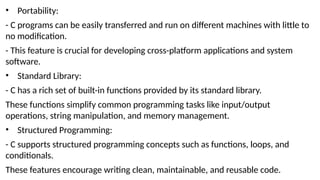





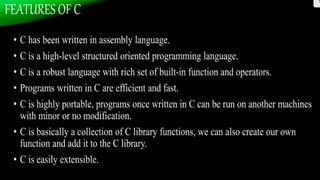












![Special Characters
We use some special characters in the C language for some special purposes,
such as logical operations, mathematical operations, checking of conditions,
backspaces, white spaces, etc.
We can also use these characters for defining the identifiers in a much better
way. For instance, we use underscores for constructing a longer name for a
variable, etc.
The C programming language provides support for the following types of
special characters:
Special characters - ` ~ @ ! $ # ^ * % & ( ) [ ] { } < > + = _ – | / ; : ‘ “ , . ?](https://image.slidesharecdn.com/cppt-250625141901-c8910b78/85/Programming-in-C-Introduction-to-C-Language-25-320.jpg)












![C Token – Strings
Strings are nothing but an array of characters ended with a null character (‘
0’). This null character indicates the end of the string. Strings are always
enclosed in double quotes. Whereas, a character is enclosed in single quotes
in C and C++.
Examples of String
char string[20] = {‘g’, ’e’, ‘e’, ‘k’, ‘s’, ‘f’, ‘o’, ‘r’, ‘g’, ’e’, ‘e’, ‘k’, ‘s’, ‘0’};
char string[20] = “geeksforgeeks”;
char string [] = “geeksforgeeks”;](https://image.slidesharecdn.com/cppt-250625141901-c8910b78/85/Programming-in-C-Introduction-to-C-Language-38-320.jpg)
![C Token – Special Symbols
The following special symbols are used in C having some special meaning and thus,
cannot be used for some other purpose. Some of these are listed below:
• Brackets[]: Opening and closing brackets are used as array element references. These
indicate single and multidimensional subscripts.
• Parentheses(): These special symbols are used to indicate function calls and function
parameters.
• Braces{}: These opening and ending curly braces mark the start and end of a block of
code containing more than one executable statement.
• Comma (, ): It is used to separate more than one statement like for separating
parameters in function calls.
• Colon(:): It is an operator that essentially invokes something called an initialization list.
• Semicolon(;): It is known as a statement terminator. It indicates the end of one logical
entity. That’s why each individual statement must be ended with a semicolon.](https://image.slidesharecdn.com/cppt-250625141901-c8910b78/85/Programming-in-C-Introduction-to-C-Language-39-320.jpg)











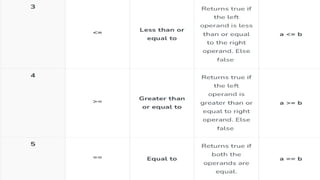



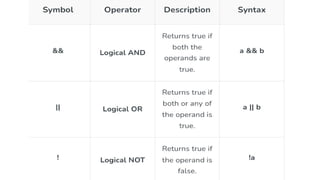


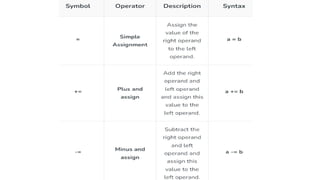






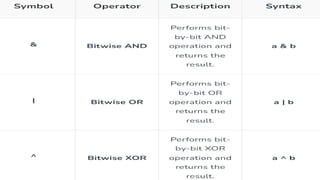



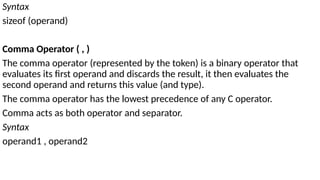


![Cast Operator
Casting operators convert one data type to another. For example, int(2.2000)
would return 2.
A cast is a special operator that forces one data type to be converted into
another.
The most general cast supported by most of the C compilers is as follows −
[ (type) expression ].
Syntax
(new_type) operand;](https://image.slidesharecdn.com/cppt-250625141901-c8910b78/85/Programming-in-C-Introduction-to-C-Language-72-320.jpg)













